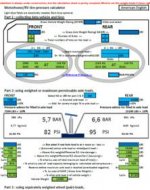Hi Eric & Alice,
Here's the bad news - Goodyear says for RV tires:
Let's assume your trailer has a GVWR of 15,500 lbs and is fully loaded and close to that weight. Assuming your pin is carrying around 2,500 of that, the tires are carrying 13,000 lbs.
Goodyear's tire inflation tables show that for the G614 (235/85 R16), if you have 13,000 lbs evenly distributed across the tires, they would need a minimum of 90 psi to carry that load. Since RV weight is not distributed evenly, you certainly have one or more tires carrying more than their share and those loads would determine how much air pressure ALL tires need, because they should be inflated the same. So if one tire was carrying an extra 300 lbs, you'd need to inflate all tires to at least 100 psi. That heavy tire would be considered running flat if inflated to 80 psi because it's 20% underinflated.
Do you have tire damage? Maybe. Goodyear says you should have the tires inspected by a trained professional - presumably not the same guy who inflated them to 80 psi.
Internal damage doesn't necessarily show up right away. At some point in the future, long after you've forgotten all about this, a tire may suddenly fail.
Here's a link to the Goodyear information.

